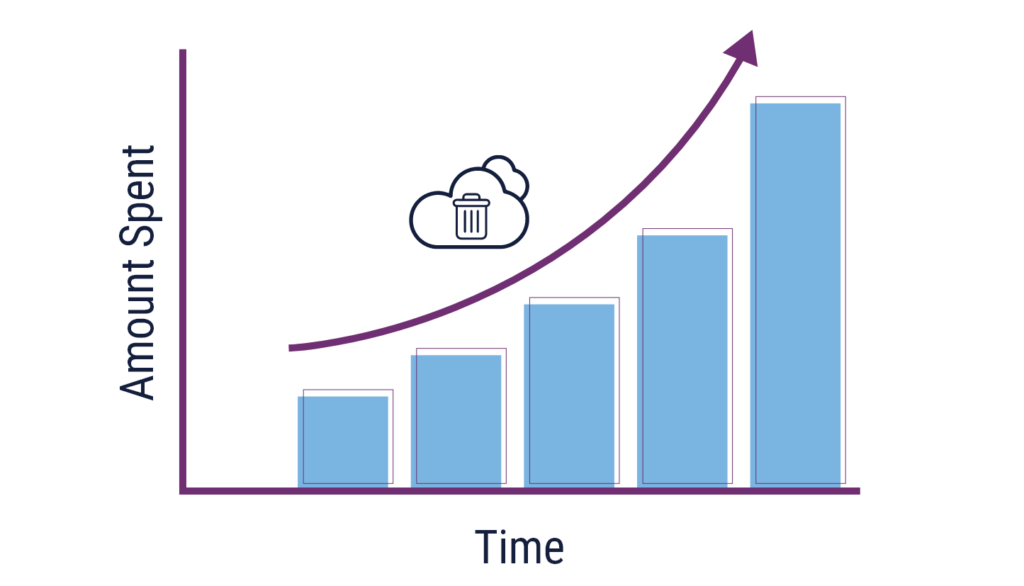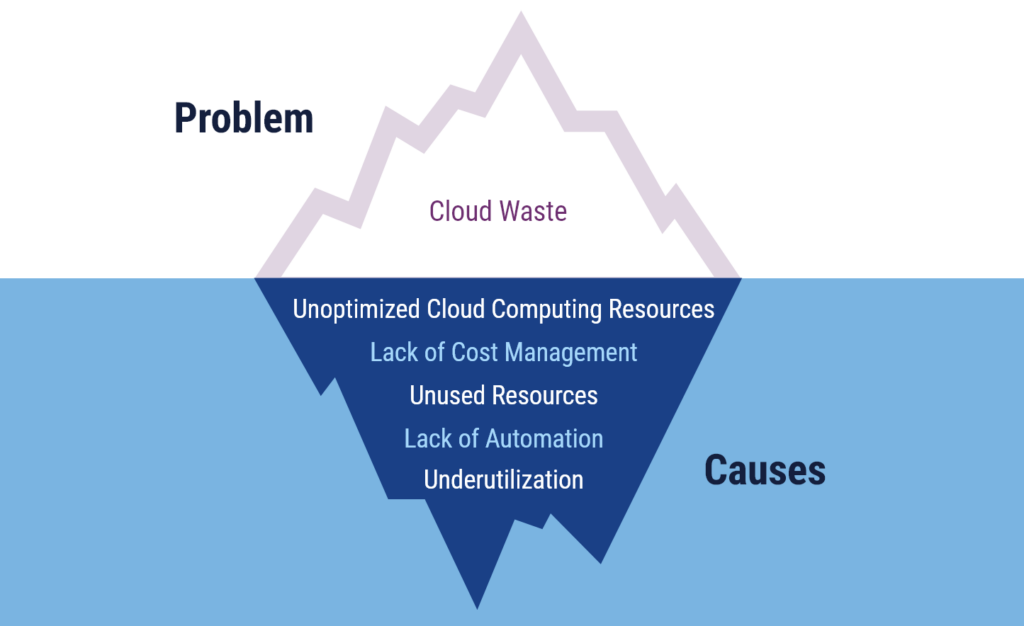
Cloud adoption is not a one-time project. It’s a continuous, iterative process that requires monitoring, management, and optimization along the way to reduce the likelihood of creating cloud waste on the road to digital transformation. When an organization has cloud waste, it’s like hosting a digital landfill – the resources are sitting there, taking up space, and the costs for these idle or underutilized resources can be high.
We’ll cover what cloud waste is, why it has continued to be a problem, and what organizations can do to reduce cloud waste in their environments.
What is Cloud Waste?
Cloud services that are not used to their full potential or ignored entirely are part of cloud waste. Sometimes, cloud waste can even come from duplicate purchases. When left unchecked, cloud waste can create significant unnecessary costs for organizations.
Why is Cloud Waste Expanding?

Part of the reason why cloud waste is expanding is because the use of cloud is likewise expanding. As more companies move their workloads to the cloud, there are more tools and costs involved. Cloud providers add new services and features regularly. It’s not unusual for a company to add something to its cloud environment, thinking the tool or service will be useful, not track its actual use, and allow it to run up a bill over time.
Without visibility into the cloud environment, this can be hard to identify. While cloud providers have tools that can help accomplish some monitoring, if your organization has a hybrid or multicloud environment, the ground you need to cover becomes more complex.
Organizations may also run into the problem of not knowing where to look or how to start monitoring their cloud usage and subsequent waste. If an IT team is already occupied with many other responsibilities, an administrative task, such as monitoring and mitigating cloud waste, can easily fall in priority.
Leading Causes of Cloud Waste

Unoptimized cloud computing resources
When cloud computing resources are misconfigured or overprovisioned, they are not optimized to their greatest potential, leading to cloud waste.
Unused resources
Another major source of waste can come from idle and unused resources. Without strong visibility into your cloud computing environment, resources can continue to be billed without being used for months, or even years.
Underutilization
Cost overruns and cloud waste can also come from underutilization. When businesses first plan the resources they need for their cloud environment, they may overestimate what they believe they will use in terms of demand, tools, and services, only to find later that they have provisioned more than is necessary.
Lack of Cost Management
Failing to optimize or eliminate used or underused resources is a problem that becomes exacerbated without cloud cost management. Cost management tools and best practices can help identify and remove major sources of cloud waste, but without a plan or tool in place, or parties responsible for managing costs, bills can balloon quickly. Visibility and monitoring are essential.
Lack of Automation
Automation can cut down on human errors and misconfigurations that can contribute to cloud waste. When you rely more on manual processes, you open your organization up to additional costs that can be easily avoided with some upfront investment.
What is the Impact of Cloud Waste?
The most significant impact of cloud waste comes from its financial consequences. Resources that aren’t needed, especially ones that have been forgotten entirely, can significantly increase cloud costs and use money that could otherwise be spent on projects that would be more beneficial to the organization. Wasted resources can also be a sustainability issue – for organizations looking to decrease their footprint, waste anywhere can pose a problem. An unsustainable organization is also less profitable.
9 Ways to Reduce Cloud Waste and Optimize Your Cloud Environment
1. Migrate in Stages
The beginning of a cloud migration project provides the perfect opportunity to review resources and apply what is needed in stages. This way, overprovisioning is less likely to occur, and cloud waste can be eliminated along the way.
Monitor Cloud Spend
Cloud cost monitoring and analytics tools can aid in reviewing cloud usage and costs on a regular basis. Amazon CloudWatch can track costs and identify any changes to bills. For organizations with multiclouds, CloudCheckr can help optimize spend across multiple clouds (such as Google, AWS, and Azure) with a single pane view. Azure Monitor can be used as a tool to monitor resources to help with Azure cost optimization, maximize performance, and enhance availability.
Implement Cost Governance Practices
Establishing polices to manage resource provisioning is essential in maintaining control over cloud spending and ensuring resources are neither underprovisioned or overprovisioned.
Resource limits can be used to outline the maximum amount of resources that can be used by a service or application, including storage, memory, or CPU. Scaling and autoscaling policies can also = implemeted to define how resources should be scaled up or down when faced with changes in demand. If CPU usage gets above or below a certain point, resources can scale along with them, for example.
Additionally, cloud tagging strategies can be used to help meet cost governance goals and enforce accountability by attributing resources to their respective teams/owners.
Implement Cost Management Tools
Cloud cost management tools can help surface areas of opportunity where companies can reduce usage or optimize resources to lower their cloud costs, thereby reducing cloud waste. Most major cloud providers offer cost management tools, including AWS Cost Explorer and Azure Cost Management.
Automate Cloud Cost Management
Establishing cloud scaling boundaries is part of setting up automated processes in your cloud environment. Cost management tools, cloud governance frameworks, and cloud advisors can also contribute to automation in cloud cost management. The more you can set up to run and govern without your intervention, the more time you free up to work on other, more strategic IT projects.
Reducing cloud waste directly impacts cloud cost optimization, and is a major focus in the practice.
Train a Cost-Conscious IT Culture
The more teams are made aware and educated on the costs associated with cloud waste, the more likely your business is to have a collective effort around reducing cloud waste. Set expectations on an organizational level by setting limits and alerts. Produce reports on usage by team or segment of the business. Discuss cloud resources with representatives from each team to understand what is being used, and how, and brainstorm ways to cut down on resources where possible.
Right-Sizing and Resource Optimization
Selecting the right size of cloud resources for your needs (rightsizing) and using resources efficiently (optimization) may sound like simple steps, but they’re often overlooked or rushed. Automation, visibility, and cost management tools can generate insights that allow you to optimize and rightsize effectively.
Eliminate Unused Resources
One of the major roles a cloud cost management tool can play in reducing cloud waste is identifying and eliminating unused resources. Resources that are no longer used or stay idle for an extended period of time, such as idle VMs, orphaned resources, unattached storage volumes, etc. can contribute to a significant of wasted cloud budget. So, it’s important to increase cloud visability to have a better understanding of what resources are needed vs. what resources are contributing to cloud waste.
Efficient Utilization of Reserved Instances and Savings Plans
For companies that have some idea of the level of resources they’ll need on an ongoing basis, cloud waste can be reduced by properly using reserved instances (RIs) and savings plans. On AWS, an EC2 reserved instance is a commitment you make with AWS to pay for a certain amount of compute capacity for a prescribed amount of time. Generally, the terms for RIs are for one year or three years; it can be difficult, and sometimes not possible, to cancel a RI, so this option is best for predictable resource needs.
Microsoft also offers Azure Reservations to help organizations save up to 72% on cloud costs over pay-as-you-go pricing if they commit to one to three-year contracts for certain products. Reservations offer a billing discount without affecting the runtime state of resources, and the discount is automatically applied to matching resources after the reservation is purchased.
Savings plans offer discounts on the hourly price of computing – the usage amount that you commit to with a savings plan is expressed in USD per hour. The prices paid for usage will stay consistent through the period of the agreement, which is usually also one year or three years. The big difference in billing between RI and savings plans are that RIs are billed as a monthly charge and savings plans are billed as an hourly expense.
The Role of Managed Cloud Providers
Cloud computing can transform your business, but it’s not without its challenges. Working with a managed cloud provider can help you make the most of your cloud environment while optimizing for cost and mitigating waste. TierPoint’s managed cloud experts can elevate your capabilities and reinvent your business, all while being conscious of your bottom line. Learn more about our cloud services and solutions.
Overflating your cloud spend? Download our eBook to uncover common challenges and discover how to start optimizing your cloud costs.
FAQs
The amount of cloud spend that is wasted is hard to estimate as it can be unique to each organization’s environment. However, in general, companies can save as much as 30% of their cloud spend when their cloud environments are properly optimized.
First, cloud waste is on the rise because more organizations are migrating to the cloud. That movement, combined with the complexity of cloud services and tools, lack of visibility into cloud environments, and need for cloud expertise on IT teams, means cloud waste has increased.
Cloud management is one of the best ways to reduce cloud waste. By monitoring the cloud environment and optimizing based on what is observed, organizations can eliminate unused resources and optimize what they have.

